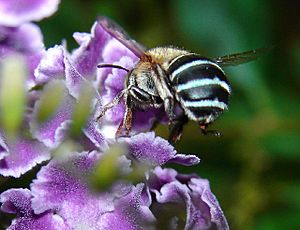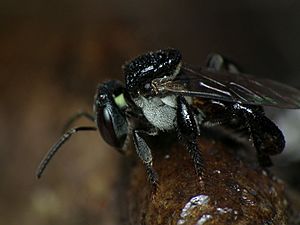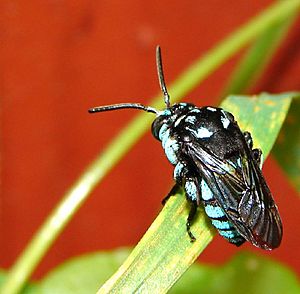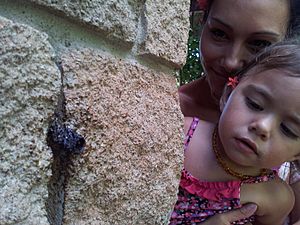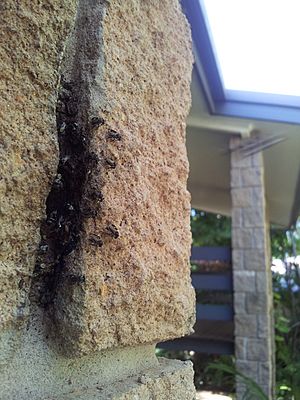Australian native bees facts for kids
Australian native bees are a special group of bees found only in Australia. They are super important for helping native plants grow by moving pollen from one flower to another. This process is called pollination. There are more than 1,700 different kinds of native bees in Australia! They come in all sizes, from tiny bees that live alone to social bees that live in big groups, like the stingless bees. These bees are vital for Australia's natural places, called ecosystems, and they also help with farming.
Contents
Stings: Do They Hurt?
Some native bees have stings, and some don't! There are eleven types of social native bees that belong to two groups, Tetragonula and Austroplebeia, and they have no sting at all. These are often called "stingless bees."
For most other Australian native bees, their stings usually don't hurt much. People often say it's "not as painful as a bull ant or paper wasp sting, and the pain only lasts a few minutes." However, a bee can sting more than once. Sometimes, a sting can cause an allergic reaction in some people, especially if they have been stung before.
Native Bee Honey
Australian native bees are not the same as the true honey bees that come from Europe, Asia, and Africa. Native bees are a more basic type of social bee, and they don't make a lot of honey. In cooler parts of Australia, the bees need all the honey they make to survive through the winter.
Collecting honey from native bee nests can be tricky. If honey spills, many bees might drown in it. The honey from native bees tastes a bit tangy compared to the honey you buy in stores, which usually comes from European honey bees. Native bees keep their honey in small, sticky pots that look like bunches of tiny grapes.
How Bees Help Plants (Pollination)
Different kinds of Australian native bees collect pollen in different ways. Scientists are studying how Amegilla bees, also known as "blue-banded bees," can help pollinate hydroponic tomatoes. Hydroponics is a way of growing plants without soil.
Some hydroponic farmers want to bring European bumblebees, Bombus terrestris, to Australia to help with pollination. However, introducing new animals to Australia has caused big problems in the past. So, deciding whether to use native bees or introduced bees for pollination is a big discussion.
Western Australia's Native Bees
About 800 different kinds of native bees live in Western Australia. Many of these bees are endemic, meaning they are found nowhere else in the world! Bees are actually a type of specialized wasp that has changed over time to eat plants instead of other insects. They mostly eat nectar. Female native Australian bees will thicken the nectar to make honey before taking it back to their nests.
Most Australian bees live alone. A female bee will build her own nest. Native Australian bees face many dangers, especially from other insects like some wasps, flies, and beetles that can be parasites.
Types of Native Bees
- Amegilla asserta (Cockerell, 1926)
- Amegilla bombiformis (Teddy bear bee, Golden haired mortar bee) (Smith, 1854)
- Amegilla cingulata (Blue-banded bee) (Fabricius, 1775)
- Amegilla dawsoni (Dawson's burrowing bee) (Rayment, 1951)
Carpenter Bees
- Xylocopa aerata (Golden-green carpenter bee, Green carpenter bee) (Smith, 1851)
- Xylocopa bombylans (Peacock carpenter bee) (Fabricius, 1775)
Reed Bees
Genus Exoneura:
- Exoneura abstrusa (Cockerell, 1922)
- Exoneura albolineata (Cockerell, 1929)
- Exoneura albopilosa (Rayment, 1951)
- Exoneura robusta
Stingless Bees
- Austroplebeia australis (Friese, 1898)
- Austroplebeia cassiae (Cockerell, 1910)
- Austroplebeia cincta (Mocsáry, 1898)
- Austroplebeia essingtoni (Cockerell, 1905)
- Austroplebeia magna (Dollin, Dollin, & Rasmussen, 2015)
- Tetragonula carbonaria (Sugarbag bee) (Smith, 1854)
- Tetragonula hockingsi (Cockerell, 1929)
- Tetragonula mellipes (Friese, 1898)


